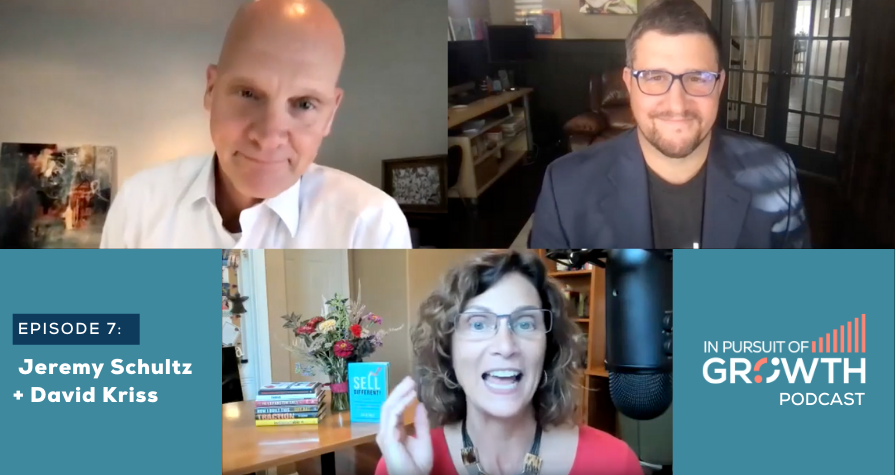This month's episode began with the question "Is sales enablement dead?" Well, it was a resounding 'no' but it may be time to reassess. I mean, sales enablement was established to enable sellers so they can engage customers and provide an exceptional experience, right? Or was it?
In this episode of the In Pursuit of Growth podcast, I had the opportunity to talk with two industry veterans of sales enablement: Dave Kriss, Modus Head of Customer Experience—and Modus President, Jeremy Schultz. Together, we uncovered some compelling insights about the industry and the direction it's headed.
The Customer Experience is Key
It’s something everyone's talking about these days. And it wraps right into sales enablement. When we enable our sellers to do their best, customers have a better experience.
Since Modus has a new initiative to make sales enablement simple, I wanted to dig into this with them.
Is Sales Enablement Dead?
 Jeremy dove right into this one. “Alice, there was a post on LinkedIn recently, where somebody asked that question. And there was quite a bit of passionate back and forth. Popular perception in the comments was, "No, of course not. Sales enablement is not dead. It's alive and well, and just as important as ever.” So, I wondered, where is this notion coming from and why would anyone be driving that message?
Jeremy dove right into this one. “Alice, there was a post on LinkedIn recently, where somebody asked that question. And there was quite a bit of passionate back and forth. Popular perception in the comments was, "No, of course not. Sales enablement is not dead. It's alive and well, and just as important as ever.” So, I wondered, where is this notion coming from and why would anyone be driving that message?
We all agreed. There's so much hype around the term, ‘sales enablement’. It's been blown out of proportion. Dave said, “It's funny, I did a Google search right before our call today. It's interesting because what came back was a listing of technology.”
Try it. Google “Sales Enablement” and you’ll see a listing of one technology after the other. It’s true there has been a tremendous amount of investment in tools for sales enablement. So, that may be the perception. Sure, tools are needed but there seems to be some confusion, and sales enablement is much more than tools.
It’s not like sales enablement just came onto the scene. We’ve all been doing it in some form or fashion for eons. But it’s all gotten kind of convoluted and overblown. Many companies don’t know where sales ops ends and enablement starts. And what about training and coaching? Then of course there is marketing. Aren’t all of these forms of enablement?
So, I did some Googling myself:
“In 1999 a consulting firm begins to uncover a sales execution problem. To address this sales execution problem, two gentlemen by the names of John Aiello and Drew Larsen began to pioneer and evangelize sales enablement as the way to improve the efficiency and effectiveness of salespeople.”
I asked Jeremy when he first started hearing the term and replied, “I first started hearing the term in 2006, 2007. And there were some early pioneers of sales enablement. They were technology vendors building software that bridged the gap between training and sales readiness, and content and resources. And they saw this need to go beyond document management and serve up the training and the content that sellers need to be effective. So, initially, it was about efficiency, effectiveness, a single source of the truth for companies' messaging, brand consistency. What's interesting is that, as time went on, it became more popular. Sales enablement became an everyday term, and certainly in the sales and sales productivity space.”
When analysts started writing about it, it really took hold. The three of us were trying to remember but we all believe that when Scott Santucci of Forrester (at the time) was one of the first analysts to really start writing about sales enablement.
Jeremy continued, “Companies started creating sales enablement departments, or sales enablement programs, that were resourced cross-functionally. And, at that time, it grew in popularity from a search standpoint. Once something starts taking over the Google search, suddenly all the product and service vendors come running and figure out a way to suggest that whatever their product or service is, it’s a sales enablement product, or service. So, it definitely started as something very specific and has grown into something much more convoluted.”
Help The Sales Team Win
The idea with sales enablement is to help the sales team be the very best they can be. So that they can deliver what buyers need, guide them through the buying journey, and help them make the very best decision for their business.
We're working to enable sellers with everything they need but, in some cases, this overly complex technology has actually disabled them. If we are truly enabling salespeople, then we need to make their tools simple to help them to be more efficient in their endeavors.
Dave made a great point:
“At the end of the day, buyers don't care about sales enablement. They don't. Buyers are trying to get their problems solved.”
It’s true, buyers are searching for answers - solutions. They are so much more self-educated, as we all know. They're getting as much information as they possibly can get before they have to talk to a salesperson.
Enable Sellers to Help Buyers
What do buyers want? The answer: they want sellers to help them navigate buying in their own organization because it’s gotten so complicated. Back in 2018 at the Gartner conference, Brent Adamson got onstage and the first thing that came out of his mouth was "more." We seem to have this need to create more. There was so much more, more, more being created and delivered for the buyer that the buyers are saying, "Stop. I don't want more. I want less. I want you to help me buy, please."
The Takeaway
The big takeaway is something you’ve probably already heard. Buyers are buying differently which means sellers need to approach buyers differently. Therefore, everyone in the organization needs to understand their buyers better. The way most sellers are selling now worked 10 years ago...maybe even 5...but it is not working now.
Dave said (and I agree) that it is incumbent on sales enablement to ‘enable’ sellers to engage a buyer in a better way. Sales enablement must work across all departments, and look at how marketing, ops, customer success and every department is engaging with the customer—to determine how to improve that experience for the customer.
Sales is Not Just About Sellers
Sales enablement is focused on enabling sellers, but that may not be enough. Because sales is a bigger picture. Sales is about bringing in revenue from customers so the focus should be on buyer enablement. And nearly every organization in the company needs to be a part of making sure that happens.
If the goal is more sales, then we can’t be focused solely on enabling sellers, we all need to understand the buyer. What the buyer is doing, their perspective, how much information they're getting, where they are getting it from, and what they're doing with that information. Sellers must understand what would prevent buyers from changing, even when it seems like the change would be better. And sales organizations need to look at the way the customer wants to buy.
Buyers don't care about sales enablement. They care about whether you are making it easy for them to buy.
Are you making information digestible? Are you making it so that they can take part of the journey on their own, and when ready, have a great conversation with somebody who’s smart, brings insight, and collaborates?
That's what the customer cares about. So, how do we make it simple? Simple both internally and externally, so customers can buy from you with ease.
Jeremy believes we are in this together and that all departments need to start from the buyer's perspective. Key in on understanding the experience they are getting vs the one they want.
Simplification—it's about aligning everybody around that goal of ensuring that our sellers are equipped and prepared to have engaging conversations with a buyer that helps the buyer move forward in the process.
Steps to Move Forward
What are some simple steps we can start taking to move forward? Because in the end, it's all about the customer experience.
Dave told me the number one way to get there is alignment. Here's the thing, we've got three different organizations that need to work together well. They just do. This is not a single team problem. The process must be aligned around customer engagement and experience, not tools.
If we want to get them aligned around that common goal of the customer experience and success, we need to change the measurement. Because customer success gets measured one way, ops is measured another, sales another and marketing another. So, how do we get those measurements aligned?
In recent years marketing is being measured on revenue, where it used to be just sales. Sales, marketing and customer success need to determine some form of measurement they all agree on. There is always the lagging indicator of whether or not the revenue goal was hit and all departments should be held accountable for that. But what is needed are leading indicators that all departments agree on.
Dave believes that adoption should be one of those measures. Sales, customer success and marketing can all get behind that and understand that user adoption matters. Low user adoption is an early indicator of a problem. But if you are agile, address it and adjust early, you can course correct.
Dave gave this example: I'm a marketer and I just launched this new product. We've created this content for sellers to engage with buyers. I'm watching the CRM. They're not engaging with buyers. Or they are, and they're getting ‘nos’ quickly. What can we do to shift the tide to make sure that we get engagement or get a yes faster? Don’t be afraid to fail and be sure to make course corrections quickly.
But this is a lot easier said than done. I asked Jeremy from a leadership point of view how do you start to orchestrate this, so we get that alignment, and the success that we're looking for?
Jeremy believes that simplifying sales enablement is moving away from trying to do so much and be so complex to setting realistic and achievable goals.
Dave added in a secret for leadership:
“If you want alignment, one of the first things to do is examine the comp plan. People do what you pay them to do and if they are not being paid to focus on customer experience through alignment – guess what – they won’t do it.”
How do you simplify sales enablement and improve the customer experience? Provide a great vision, get your team aligned around the customer experience, measure the right things and ensure the comp plan encourages the behavior.
In the words of Jeremy Schultz, “More can be too much. Sometimes it’s about simplicity.”
My suggestion: get your team together and discuss this question, how can we simplify sales enablement to give the customer a better experience. Instead of doing more, how can we do it better? And I think most time, you’re going to find that better means make it simple.
There is so much more to this conversation, I hope you will listen while you are taking a walk or have a long drive ahead because you will want to hear it all.



